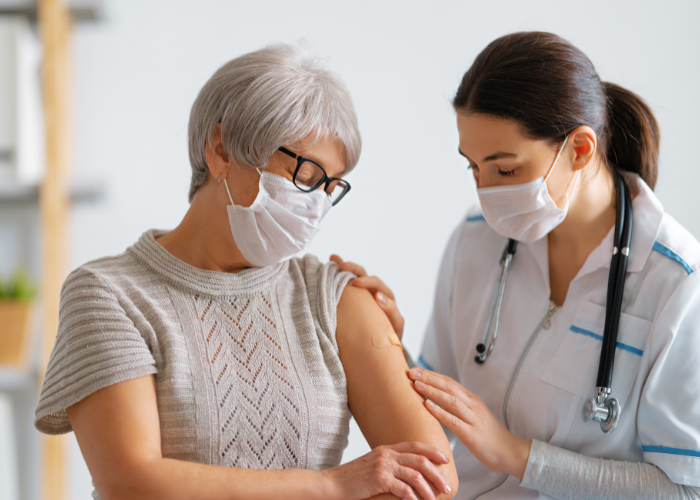| 2021 | 38 |
| 2010 | 52 |
| 2000 | 76 |
| 1990 | 93 |
| 1980 | 132 |
Trade Fact series editor Ed Gresser, testifying at the House Judiciary Committee last week on COVID-19, the WTO’s intellectual property rights (“TRIPS”) agreement, and the WTO members’ decision to authorize a temporary waiver of some patent rules last summer, was asked whether the COVID pandemic had definitively “ended.” Having been down with a (very mild) COVID bout the previous week, his answer was (i) a rueful but clear “no.” But (ii) with mass vaccinations — 82% of Americans, 70% of the world — the danger COVID posed to life and health has been greatly diminished. So (iii) the Biden administration’s decision to declare the “public health emergency” phase of the pandemic over was the right call.
To get to this point, in three years the world’s science, industry, pharmacies, clinics, and hospitals have moved from:
(a) Not quite a standing start (though close to it): as of early 2020, scientists had some knowledge of coronaviruses generally, and could make use of mRNA and nanotech technologies developed in the 1970s and 1980s and first used in development of an Ebola virus, but had no knowledge of the actual COVID-19 virus before its isolation in December 2019; to
(b) A safe, effective, and transportable vaccine by December 2020; and then
(c) Manufacturing, logistical, and primary-care delivery systems at a scale needed for a patient population comprised of “the whole human race” by mid-2021; and finally
(e) Delivery of 13.4 billion actual vaccinations and booster shots — almost two for everyone in the world — as of mid-2023.
Thus a landmark achievement in a very short time for policy, science, manufacturing, logistics, and public health providers worldwide. Pulling back a bit, the speed in this case was exceptional. But as a large-scale achievement of policy, production, delivery, and public health it wasn’t entirely unique. In fact, it is one with many precedents, and is part of a larger story of remarkable successes in vaccination generally. Polio is a particularly striking case, with complete eradication of the disease now achingly close. Here’s a count of polio cases worldwide over the last 25 years:
| 1988 | 350,000 cases |
| 2010 | 650 cases |
| 2020 | 6 cases |
Measles presents a second example: an easily transmissible disease mostly affecting children, for which large-scale vaccinations began with a U.S. launch in March of 1963, and deaths have dropped by 95% over the last generation, from 2.6 million deaths a year to 600,000 in 2000, 210,000 in 2010, and 128,000 in 2021. Likewise deaths of neo-natal tetanus, after campaigns to vaccinate pregnant women and guarantee antiseptic standards in poor-country maternity clinics, have dropped from 787,000 in 1988 to 309,000 in 2000 and 25,000 in 2018 (the last year for which data is available).
Overall, the invention of new treatments and medicines, worldwide vaccination campaigns, and improving primary-care delivery have helped cut world under-five mortality rates from 132 per 1,000 children in 1980, to 78 per thousand in 2000, and 32 per thousand in 2020, or in overall terms by 70%.
Against this background, the success of the vaccination program for COVID-19 is, again, a remarkable success of focused policy in emergencies, scientific research and development, manufacturing and logistics technologies, and delivery systems. Its speed has been particularly impressive (and the Trade Fact series editor is appropriately grateful). But it’s especially heartening to see that this is not something entirely unique, but more like a representative case in the larger vaccine story.
* More precisely, the Judiciary Committee’s Subcommittee on the Courts, Intellectual Property, and the Internet.

COVID-19:
Gresser on WTO intellectual property rules as supporters of research, exceptions in emergency situations, and the Biden administration’s reasonable choices.
… and from the House Judiciary’s Subcommittee on Courts, Intellectual Property and the Internet, the hearing video and testimonies.
Chad Bown of the Peterson Institute for International Economics maps the international science, manufacturing, and logistical “supply chains” which created COVID-19 vaccines.
HHS’ Office of Global Affairs on U.S. work.
And Our World in Data has stats for Covid vaccinations, cases, deaths, and more.
Background:
The World Health Organization on vaccines.
… and an update on hopes for measles eradication in the next decade.
Ed Gresser is Vice President and Director for Trade and Global Markets at PPI.
Ed returns to PPI after working for the think tank from 2001-2011. He most recently served as the Assistant U.S. Trade Representative for Trade Policy and Economics at the Office of the United States Trade Representative (USTR). In this position, he led USTR’s economic research unit from 2015-2021, and chaired the 21-agency Trade Policy Staff Committee.
Ed began his career on Capitol Hill before serving USTR as Policy Advisor to USTR Charlene Barshefsky from 1998 to 2001. He then led PPI’s Trade and Global Markets Project from 2001 to 2011. After PPI, he co-founded and directed the independent think tank Progressive Economy until rejoining USTR in 2015. In 2013, the Washington International Trade Association presented him with its Lighthouse Award, awarded annually to an individual or group for significant contributions to trade policy.
Ed is the author of Freedom from Want: American Liberalism and the Global Economy (2007). He has published in a variety of journals and newspapers, and his research has been cited by leading academics and international organizations including the WTO, World Bank, and International Monetary Fund. He is a graduate of Stanford University and holds a Master’s Degree in International Affairs from Columbia Universities and a certificate from the Averell Harriman Institute for Advanced Study of the Soviet Union.
Read the full email and sign up for the Trade Fact of the Week